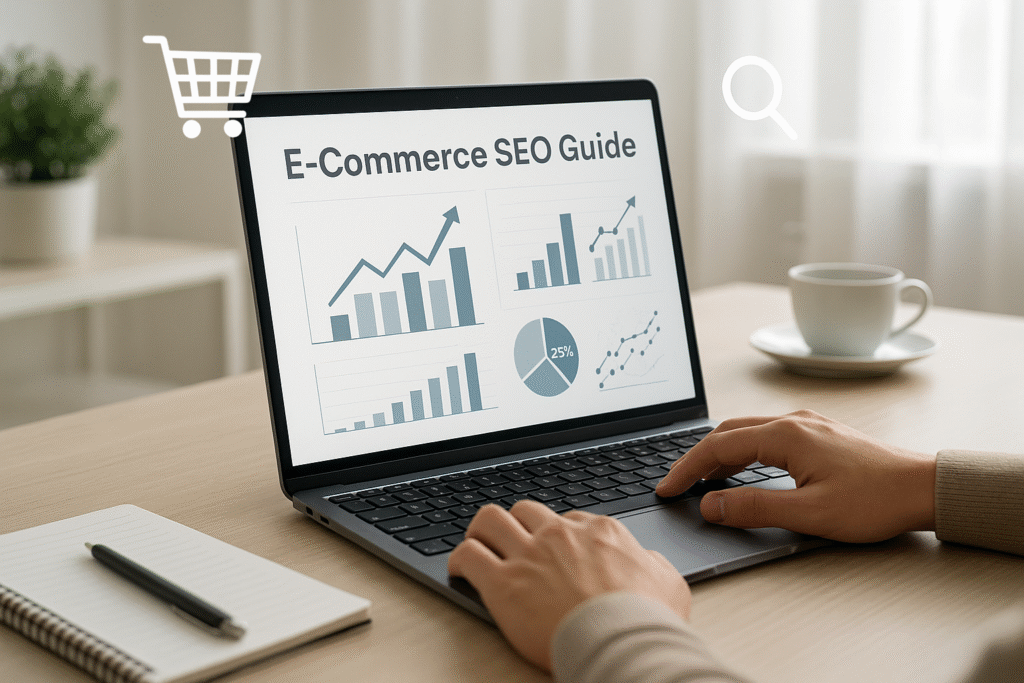Introduction
The world of online shopping is growing faster than ever. Every day, millions of customers search on Google before buying anything — clothes, electronics, skincare, food, home decor, you name it.
But here’s the truth:
If your store is not visible on Google, your customers will buy from your competitors.
That’s where E-Commerce SEO comes in.
SEO (Search Engine Optimization) means improving your online store so that customers can find you easily on search engines like Google. In simple words:
E-commerce SEO helps your products rank higher → get more traffic → get more sales.
This beginner-friendly guide will help you learn step-by-step ecommerce SEO, even if you’re new.
✅ What is E-Commerce SEO?
E-commerce SEO means optimizing your online store to show up on Google when customers search for products you sell.
Example searches:
- “best running shoes for women”
- “budget gaming laptop”
- “kid’s cotton t-shirts online”
- “hair growth serum price”
If your product pages rank for these keywords, you earn free traffic and sales — without paying for ads.
✅ Why E-Commerce SEO Matters
| Benefit | Explanation |
|---|---|
| Free Traffic | Google sends customers without ads |
| Higher Sales | People searching already want to buy |
| Trust & Authority | High ranking improves brand value |
| Long-Term Results | One-time work gives results for months |
| Low Marketing Cost | Saves money compared to paid ads |
SEO = Traffic + Trust + Sales
Ads stop when money stops.
SEO keeps working even while you sleep.
✅ How Google Chooses Which Store to Rank
Google wants to rank stores that:
✔ Have useful product information
✔ Load fast
✔ Are trusted by customers
✔ Have good reviews
✔ Have proper keywords
✔ Provide great user experience
We will build all these step by step.
✅ Step-by-Step E-Commerce SEO Guide
1️⃣ Keyword Research (Find What People Search For)
Your SEO starts by finding the right product keywords.
✅ Tools to use:
- Google Keyword Planner (Free)
- Ubersuggest
- Ahrefs
- SEMrush
- Keyword.io
- Amazon search suggestions (free goldmine!)
- Etsy search suggestions
✅ Types of keywords
| Keyword Type | Example | Use |
|---|---|---|
| Product keywords | “leather laptop bag” | Product pages |
| Category keywords | “men’s bags” | Category pages |
| Informational keywords | “how to clean leather bag” | Blog posts |
| Buying intent | “buy laptop bag online” | High value |
Always target long-tail keywords:
“black leather laptop bag for office men”
More specific = less competition + more sales.
2️⃣ Optimize Product Pages
Every product page should be Google-friendly.
✅ Key Checklist
- Product Title with keyword
- SEO-friendly URL
- Product description (unique, helpful)
- High-quality images
- Bullet points & benefits
- Customer reviews
- Mobile-friendly layout
✅ Example Title Formula:
Keyword + Material/Feature + Who It’s For + Brand (optional)
Example:
Leather Laptop Bag for Men – Waterproof Office Travel Bag
✅ URL Example:
yourstore.com/leather-laptop-bag-men
✅ Product Description Tips:
- Explain features + benefits
- Mention use cases
- Answer common questions
Avoid copy-paste manufacturer descriptions. Google hates duplicate content.
3️⃣ Category Page SEO
Category pages rank faster than product pages.
✅ Add:
- Category heading with keyword
- 100-200 word intro content
- Filter options (size/color)
- Internal links
Example:
Best Leather Bags for Men – Office, Travel & Daily Use
4️⃣ Technical SEO for E-Commerce
✅ Must-haves
| Feature | Why |
|---|---|
| SSL (HTTPS) | Trust & ranking |
| Fast loading | Better experience |
| Mobile-friendly | Most buyers are mobile users |
| Image compression | Faster speed |
| Sitemap | Helps Google index pages |
| Robots.txt | Controls what Google sees |
Use tools:
- Google Search Console
- Google PageSpeed Insights
5️⃣ Product Reviews & Ratings
Google loves real customer feedback.
Request reviews via:
- Email follow-ups
- WhatsApp message after delivery
- Offering reward points
More reviews = higher trust = more conversions
6️⃣ Internal Linking
Link related products and blog posts.
Example:
People also buy → recommended products
Improves navigation + boosts SEO.
7️⃣ Create Helpful Blog Content
Blogs bring targeted traffic.
Write topics like:
- Best [product type] for [audience]
- How to choose [product]
- Maintenance & care guides
- Comparison guides
Example topics:
- Best Leather Bags for Office Professionals
- How to Clean & Maintain Leather Bags
- Backpack vs Messenger Bag — Which is Better?
Blogs help:
✔ Build authority
✔ Attract search traffic
✔ Improve product rankings
8️⃣ Link Building
Earn links naturally by:
- Guest posting
- Influencers & bloggers
- PR articles
- Partnerships
- Free guides & ebooks
More quality links = higher rankings.
9️⃣ Social Signals & Branded Searches
Your brand matters.
Google tracks:
- Social media presence
- Brand mentions
- Search volume for your store name
Be active on:
- YouTube
- Pinterest (very powerful for ecommerce!)
🔟 AI Tools to Boost E-Commerce SEO
| Purpose | Tool |
|---|---|
| Keyword Research | ChatGPT + SEMrush |
| Product Descriptions | ChatGPT |
| Image Optimization | Canva / TinyPNG |
| Content Writing | Jasper |
| Review Automation | Loox / Judge.me |
| Technical SEO | RankMath / Yoast |
AI makes SEO faster & easier.
✅ Common SEO Mistakes
❌ Copying product descriptions
❌ No keyword research
❌ Slow website
❌ Over-stuffing keywords
❌ Not using unique images
❌ No review collection system
Avoid these and you’ll grow fast.
✅ Timeline to See Results
| Time | Results |
|---|---|
| 1-2 Months | Better visibility |
| 3-4 Months | Improved rankings |
| 6 Months | Strong organic sales |
SEO is slow but long-term profitable.
✅ Conclusion
E-Commerce SEO is the foundation of long-term success online.
Ads can give instant sales — but SEO makes your brand unstoppable.
To win in e-commerce:
✔ Research keywords
✔ Optimize product pages
✔ Build trust with reviews
✔ Use blogs to educate
✔ Improve site experience
Start today — Google rewards action.
The earlier you start SEO, the faster you grow.


